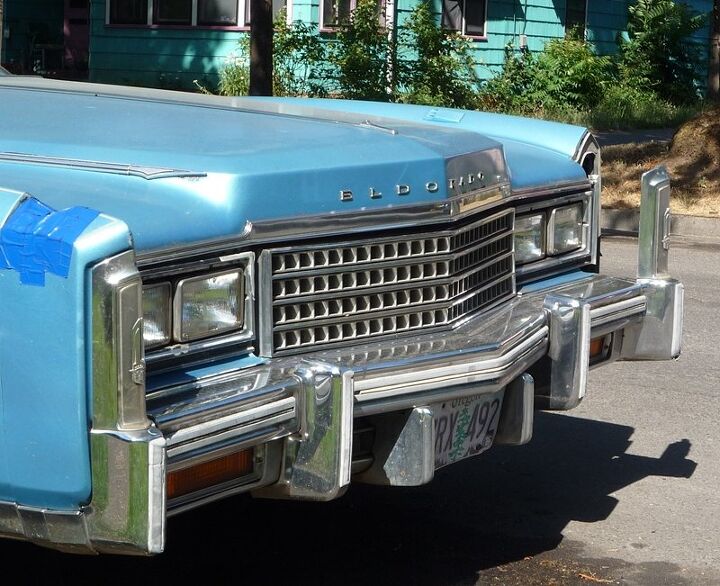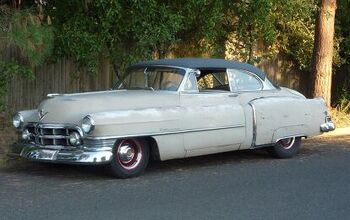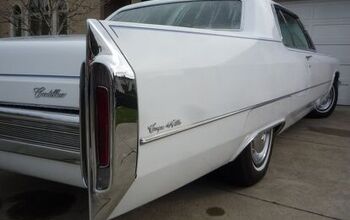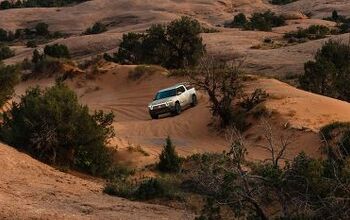Curbside Classic: 1978 Cadillac Eldorado Biarritz Classic Coupe

What words shall we use to describe this 1978 Cadillac Eldorado Biarritz Classic Coupe? (actually, it might be a 1978 Cadillac Eldorado Custom Classic Biarritz Coupe). Maybe we don’t need any more words at all; the name pretty much says it all. But let’s throw a few at it and see if they stick: faded glory, wretched excess, the last big Eldorado, the perfect symbol of the seventies, the Bizarritz, a bloated horror, a handsome classic; we could go on all day (and I invite you to add your own to the list). Or we could just look at it in wonder (horror?), this vivid reminder of just how far we’ve come as well as Cadillac with their new CTS Coupe, since the decade when this Eldorado and its Lincoln Mark IV and Mark V counterparts roamed this land, proud and unfettered.
Well, maybe proud, but not exactly unfettered. When the new 1971 Eldorado first burst forth from its Brontosaurus sized egg, it proudly proclaimed the title of the biggest engine ever in a post-war car. A nice round 500 cubic inches (8.2 liters) cranked out some 365 (gross) horsepower and about as much torque as a ship’s prime mover. Somehow, the Eldorado’s engine stumbled through energy crisis one without giving up a precious cubic inch, but in 1977, it lost the title. The big Caddy V8 started out in 1968 with 472 cubic inches and was designed to potentially grow up to some 600 cubes in the expansive mood and outlook of the times. For 1977 and 1978 it now was 425 cubic inches and 195 (net) horsepower, but this wasn’t the last stop in the gelding process.
Perhaps Caddy waited until 1977 because they wanted the last convertible Eldorado in 1976 to bow out in 8.2 liter style. That caused quite a sensation and a run on them, having been dubbed the last American convertible ever due to proposed roll-over restrictions that were later rescinded. So to throw a little interest in the coupe after the passing of the rag top, the Biarritz, and its Custom and Classic variants were deployed in that Super-Fly era of Eldorado customs.
The wretched excess and tastelessness of the seventies custom era were all the classic signs that this era of giant personal coupes was already morbid, and due to be resigned to the schlock and kitsch chapters of automotive history. I doubt Cadillac envisoned that when the dramatic 1967 FWD Eldorado first appeared in its knife-edged glory. Trying to recapture the exclusive and true luxury of earlier coupes, like the 1956 Continental, the Eldo arrived at a critical time for Cadillac and Americans. Incomes were up, taxes were lower, as were Caddy prices. Whereas the failed Continental coupe was truly exclusive, the Eldorado ushered in the era of affordable non-exclusivity. And in doing so, it sowed the seeds of the ultimate destruction of the genre.
Lincoln’s down-scale but up-sized Mark III of 1969 managed to capture the public’s frenzy for long-hood luxo-coupes even more definitively, and outsold the Eldorado by healthy margins during their heyday. The ’67 Eldorado’s styling was still trying to be a bit “interesting”; the Mark III was just a blatant land-grab for the biggest hood and most pretentious grille. Not surprisingly, that was the formula for success.
The 1971 – 1978 Eldorado was not a particularly handsome beast, foreshadowing American’s battle with love handles. Lincoln’s Marks stayed with the angular ultra-long hood theme, and steam-rolled the pudgy Eldo. The Eldorado wasn’t an inspiring car to drive either; which probably won’t come as a surprise to those whose lives might feel incomplete for not having had wheel time behind one of these. Use your imagination, and you’ll have the experience down perfectly: billowing, narcoleptic, floating, swimming, drowning, slewing, sloshing; you Eldo drivers feel free to add more to the list.
Obviously, the plastic material Cadillac used to fill the gaps between the steel fenders and the bumper end caps was not a long-lived substance. I see Caddys of this vintage and into the eighties with these charming gaps everywhere. And that’s in western Oregon, one of the most benign climates for solar damage. I find them to be a fitting symbol of the decay of America’s big luxury cars, when cheap plastics were massively employed for all sorts of fraudulent roles inside and out. You won’t see this happening to a 1978 Mercedes. Live and learn.

More by Paul Niedermeyer
Latest Car Reviews
Read moreLatest Product Reviews
Read moreRecent Comments
- MaintenanceCosts Poorly packaged, oddly proportioned small CUV with an unrefined hybrid powertrain and a luxury-market price? Who wouldn't want it?
- MaintenanceCosts Who knows whether it rides or handles acceptably or whether it chews up a set of tires in 5000 miles, but we definitely know it has a "mature stance."Sounds like JUST the kind of previous owner you'd want…
- 28-Cars-Later Nissan will be very fortunate to not be in the Japanese equivalent of Chapter 11 reorganization over the next 36 months, "getting rolling" is a luxury (also, I see what you did there).
- MaintenanceCosts RAM! RAM! RAM! ...... the child in the crosswalk that you can't see over the hood of this factory-lifted beast.
- 3-On-The-Tree Yes all the Older Land Cruiser’s and samurai’s have gone up here as well. I’ve taken both vehicle ps on some pretty rough roads exploring old mine shafts etc. I bought mine right before I deployed back in 08 and got it for $4000 and also bought another that is non running for parts, got a complete engine, drive train. The mice love it unfortunately.









































Comments
Join the conversation
The 500 CID engine was standard equipment on the 1970 Eldorado. It expanded to the entire Cadillac lineup in 1975. The car shown has the Biarritz option consisting of the spear-like bodyside molding, the padded cabriolet vinyl roof with the smaller backlight and the pillow-tufted interior. For 1978, five colors were offered for the Biarritz package: white, red, blue, yellow and brown. Offered as a mid-year upgrade was the Biarritz Classic featuring two-tone (beige and brown) exterior paint and two-tone leather seating plus gold script. The 425 CID engine of 1977 might have been acceptable in the deVille and Fleetwood models (about 1,000 pounds lighter than their '76 counterparts) but it was no match for the 5,000 pound Eldorado. I drove a '78 Eldorado Biarritz up a hill and was certain there was a mechanical problem with it. Nope, it just didn't have enough power. Lovely cars, performance aside. The pillow seating is very comfortable.
I saw this 12 year old entry for the first time because someone else had posted a comment on it. To my surprise the vehicle it featured was identical to one that My Old Man had. It was his first Cadillac. Immediately prior he had a Bill Blass edition Mark V. The Eldorado was something of a disappointment.